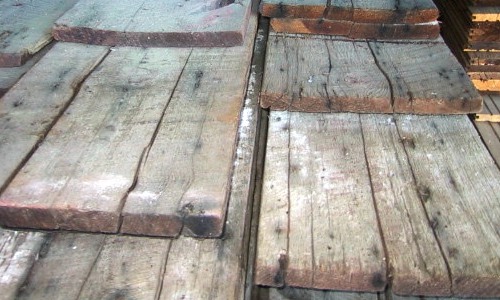Reclaimed, rediscovered, recovered, recycled, and reused are terms that refer to wood that has been given a new lease on life. The category includes: 1) timber recovered from river beds, lake bottoms, swamps, and the forest floor; 2) wood previously used in industrial mills, warehouses, barns, homes, boats, wine tanks, railroad ties, fences, furniture, and other products; and 3). wood salvaged from diseased trees, storm damaged trees, old orchards, driftwood, landfills, and various types of urban “debris”.

Reclaimed barn lumber
Environmentally, reclaimed woods are the soundest choice because their use replaces the need to harvest new timber. The wood is already out there, it’s just a matter of finding it, cleaning it, and milling it. Woodworkers that use reclaimed woods find that they are definitely worth the extra effort since many of these woods have a richness of grain, color, and character that is unmatched in woods found today. And wood from old-growth trees come in sizes that are virtually impossible to find today. Some of the best quality wood comes from old-growth trees. Old-growth timber is often harder, denser, and more dimensionally stable than wood from young trees. (Much of this stability comes from the fact that the wide trees yielded so much quarter-sawn lumber). It also tends to have fewer knots and structural defects. Of course, reclaimed woods may have nail holes, metal stains, and other imperfections, but that’s part of the appeal of these woods.
Another appealing aspect of reclaimed wood is that each piece is virtually one of a kind with its own distinct character and history. Products made from reclaimed wood products provide a sense of history and place. When the old baseball stadium is torn down, it means something to receive a baseball bat made from beams in the old building as a gift. Likewise for kitchen cabinets that you made for your home from woods salvaged from Grandpa’s old barn or smokehouse. Grandpa would be proud of you.
A number of companies have emerged in recent years to sell products made from recovered woods. For example, at Mendocino Specialty Lumber in Hydesville, CA, they salvage old-growth redwood logs that were felled in the late 1800’s or early 1900’s, and were left on the forest floor for various reasons. These logs are then milled into siding, paneling, wainscoting, flooring, and a number of other specialty wood products. As another example, Whit McLeod makes arts and crafts tables and other furniture from recycled white oak wine casks that were originally put into service in the late 1800’s. (some with 7 to 12 foot long quarter sawn white oak staves!). And, CitiLog has established an entire business of creating custom millwork from salvaged city logs.
Some of the most popular reclaimed woods are the oaks, particularly white oak because of its strength, stability and the beautiful antique patina it achieves over time. Old growth heart pine, nearly extinct, is a popular wood that grew in the southeast U.S. and is obtained from old warehouses and factories. Old-growth redwood and Douglas fir are commonly “rescued” in the western U.S. Other favorites include chestnut, black cherry, cypress, hemlock, and white pine. Some woods, such as the American chestnut, are virtually extinct, so large beams and planks from these species are particularly prized.
Perhaps the main drawback to using reclaimed wood is the effort involved in cleaning the wood, removing any nails or other debris embedded in the wood, and milling the wood into usable sizes. Depending on the source of the wood, this prep work can be very labor-intensive which is why reclaimed lumber can be quite pricey — unless you do it all the work yourself.

